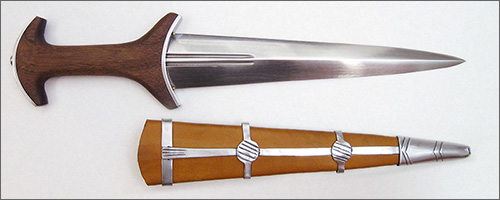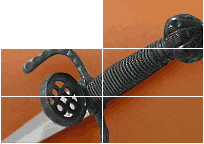Arms & Armor Custom Swiss Dagger
Original: Swiss, late 13th to early 14th century

While obviously of Swiss origin, as the names
Baselard (from the Swiss city of Basel) and
Swiss dagger would imply, daggers of this family were popular throughout Europe. First seen in the late 13th century, they continued in various forms for hundreds of years, making them one of the longest-surviving dagger forms. These early examples typically feature grips of wood with protective metal bands in place of the guard and pommel typical of quillon daggers; these bands were often secured to the wooden grip with pins. Blades could be single-edged or double-edged, and cross-section could be diamond or triangular.
This dagger draws its components from multiple originals, all from the Schweizerisches Landesmuseum and all dating to the late 13th and early 14th centuries. The wooden grip is walnut and is mated to steel bands that are pinned into the grip from either end with brass pins. The blade is steel. Its top face features two short, narrow fullers and a strong mid-rib while its back is flat. This asymmetrical double-edged, triangular cross-section is present on several examples in that museum.
The scabbard, also based on an example from the Schweizerisches Landesmuseum, is made of two layers of leather. It is enclosed by a metal frame and chape, brazed together, all decorated with filework.
See our
hands-on review for more information on this dagger.
Overall length: 14.5"
Weight: 10.625 ounces
Width of guard: 3"
Blade: 9.5" long; 1.75" wide tapering to .5"
Grip and pommel: 4.9"
Maker:
Arms & Armor of Minnesota.


